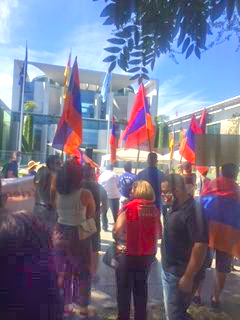
Germany’s Armenians
Respond to Aggression
by Muriel Mirak-Weissbach
BERLIN, AUGUST 6, 2020 — “Make dolma not war.” That is the message that Haykanush Sechelyan transmitted on a poster during a demonstration in Hamburg, Germany on August 1.
A member of an Armenian youth group, she was one of many in several cities, who had come together to protest acts of violence against Armenians over the past ten days.
On July 23, an official car of the Armenian embassy was set ablaze in front of the diplomatic mission. In the days following, a taxi agency and an Armenian shisha bar in Cologne were attacked; according to eyewitness accounts, 30 men wearing black facemasks assaulted the site, throwing chairs and tables through the glass windows before fleeing. All signs indicated that Azerbaijanis were behind the acts of violence, which came in parallel to Turkish-Azerbaijani military maneuvers on the Armenian border and escalated aggression by Azerbaijan.
The Central Council of Armenians in Germany (ZAD) issued a call on July 31, denouncing these and other acts of violence, and called for a demonstration in the German capital. In light of the escalating military conflict, the ZAD warned that Azerbaijani forces would transport the violence to German soil. In addition to the arson and vandalism, Armenians in Germany had been targeted with hate mail and threatening phone calls. “After such developments, one must ask the question: How secure is life for Armenians today in Germany?” asked the ZAD. The press release called on the German government to act, by “reinforcing the peace process and by suspending arms exports to Baku and Ankara.” It demanded “an initiative on the part of the German Chancellor’s office and the Foreign Ministry to stop Azerbaijan and to guarantee the security of German-Armenians here.” Furthermore it demands “the Turkish President, who fuels the conflict and has already assured Baku his support, urge restraint. For the Armenophobia that President Erdogan has been nourishing, can become the fuse for unforeseeable events on German soil.” Over 30 Armenian organizations signed the call for a demonstration in front of the Chancellor’s office, to warn against the possible consequences that the escalation of tensions may have on “the peace process in the Caucasus, security in Europe and the security of Armenian associations in Germany.”
On Saturday, representatives of Armenian groups nationwide gathered in the German capital in a disciplined assembly. As Bea Ehlers-Kerbekian reported, it was more a political gathering than a demonstration. Speakers, who included Azat Ordukhanyan of the Armenian Academic Society 1860 (AAV 1860) and Gerayer Koutcharian of the Working Group for Recognition, Against Genocide, for Understanding among Peoples (AGA), sought to explain the events, provide an accurate account of the threats and acts of violence that had occurred, and demand political action in response. Both the German government and the European Union should intervene, cease arms deliveries, and engage in diplomatic moves to de-escalate in the region.
Responding through Art
As reported in this newspaper, the Armenian Ambassador in Berlin Ashot Smbatyan had urged Armenians not to take part in unauthorized protest demonstrations, in an effort to avoid escalating tensions and prevent the outbreak of violence between Azerbaijanis and Armenians, whether in Germany or elsewhere. The Berlin authorities, both political and police, had been fully informed and were investigating to identify the perpetrators. Smbatyan sought to maintain calm and to prevent any acts that might provide a pretext for provocations.
If not though public demonstrations, then one most effective means of responding is found in art. To be sure, at the Berlin gathering, poems and music also played a part. But more is in the offing. Archi Galentz, artist a gallerist in the capital, announced on July 30 a major initiative, a special exhibition, dedicated to the theme: “Armenia: Gracefulness and Violence. Pictures of Landscapes and Traces of War.”
“Behind every exhibition lies a reason,” the announcement reads, and “this exhibition is simply a spontaneous reaction — a reaction to the renewed aggression by the south Caucasus Republic of Azerbaijan against the neighboring Republic of Armenia.” For three decades, hatred and violence have prevailed, and recently Turkish President Erdogan called for his country and its “sister” Azerbaijan, to complete the “mission of their forefathers.” Such statements reopen the wounds of the 1915 genocide, which is still being denied.
“Armenia,” the announcement continues, “lies in the crossroads of many different cultures and has developed its own emotional approach to the world. Even in landscape painting this independent character is recognizable.” Thus special relationships in space and color have contributed to creating “a unique aesthetic in painting.” And “singing praises to the barren mountains has even become a species of its own in visual art.”
The exhibition, which opens on August 9 and runs until August 30, presents landscapes from private collections in Berlin. The artists include Mher Abeghjan, Seda Bekarjan, Hakob Hakobjan, Khachatur Jesajan, Harutyun and Armine Kalenz, Vanik Sharanbeja, Henrikh Siravjan, Albert Tzovjan, Hovhannes Zardarjan, among others.
Counterposed to these paintings and drawings are photographs of landscapes by Zaven Sargsyan. The well-known photographer is founder and director of the Paradjanov Museum in Yerevan and has exhibited worldwide for the past 30 years. Among the works presented is a photo of the 13th century.
Khoranashat monastery in Tavush region, which was “liberated from the line of fire of sharpshooters” just a year ago and made accessible to the public after more than two decades. There are also photographs from 2016 and from this summer, that document the traces of artillery fire in the inhabited border region. The Spiritual Renaissance Tavush Foundation made them available for the exhibition. The juxtaposition of the photographs and the paintings enhances the contrast between gracefulness and violence that have characterized the rhythm of life in the border region.
The exhibition, which will be held in the Wolf & Galentz gallery in Berlin, is the product of cooperation between the Association of the European and Armenian Experts e.V. (AEAE) and the Armenian Artists Association of Tavush Region.